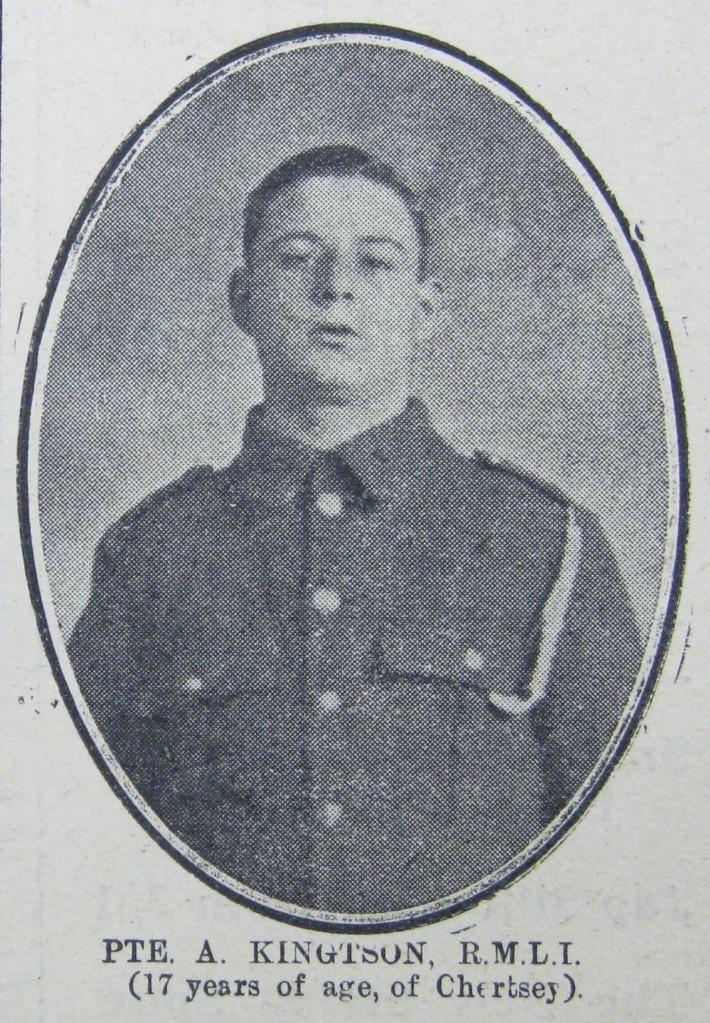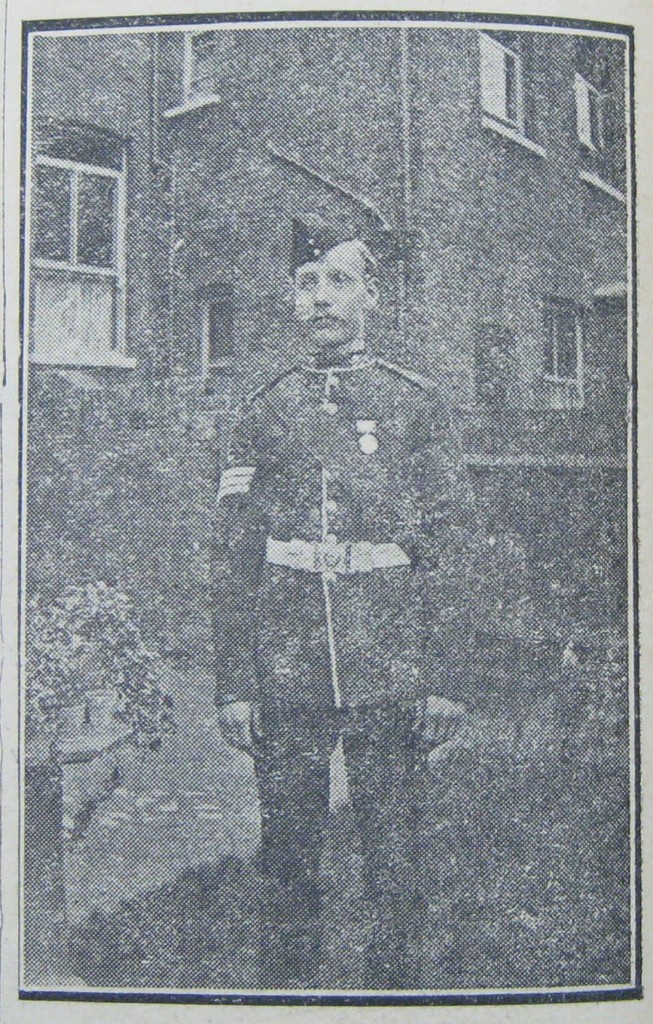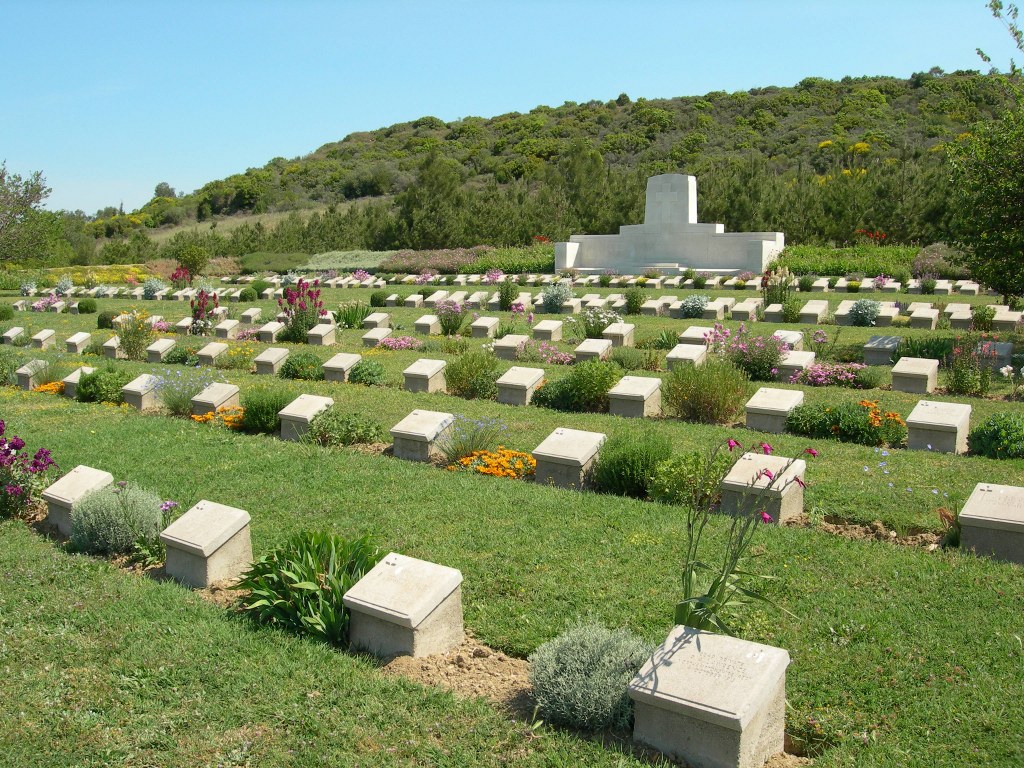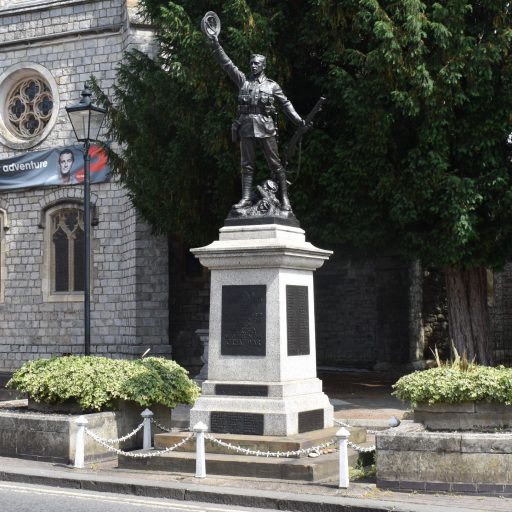This year is the 40th anniversary of the release of Peter Weir’s poignant feature film ‘Gallipoli’ starring Mel Gibson and Mark Evans. The film tells the story of two fictional Australian soldiers who are sent with thousands of others from Australia and New Zealand to the Gallipoli peninsula, then part of the Ottoman Empire. In the four decades since the film’s release, a visit to Gallipoli at dawn on Anzac Day, 25 April, has become an essential part of the travel experience for many Australians and New Zealanders.

Image credit: ASSOC R&R Films / Paramount / Album / Universal Images Group.
Rights managed / For education use only.
Gallipoli has a lower profile in the United Kingdom even though far more British than Australian and New Zealand troops fought and died in the campaign. Four of the men commemorated on the Chertsey Town War Memorial lost their lives on the peninsula between May and October 1915. At just 17, Arthur Kingston was one of the youngest named on the memorial. In contrast, Henry Wilson was a veteran of the Second Boer War who re-enlisted in his mid-thirties. The homes of these two men, either side of Chertsey railway station, were just a few minutes’ walk from each other.
Arthur Frederick Kingston was born in 1897 to James and Zillah Kingston. He was one of at least nine children with five older siblings and three younger. The family home was a railway cottage long since demolished at 3 Fox Lane South. Arthur’s father worked as a labourer, and before the war Arthur was employed at the Addlestone Leather Factory. Like many young men from large working class families, the military offered Arthur the prospect of adventure as well as regular pay, meals, and a bed that did not have to be shared with siblings. In July 1914 aged 16, he enlisted in the Royal Marine Light Infantry based at Chatham, just before the outbreak of hostilities.

The Chatham Battalion was dispatched to Dunkirk on 20 September 1914 and then to Antwerp in early October. From this fortified city, the main Belgian army along with a small British force held up the German advance until Allied troops arrived to assist with the evacuation. Some records suggest that Arthur Kingston could have been sent to Belgium but, only two months after enlisting, he probably remained in Chatham and continued his basic training. Many of those who survived the evacuation of Antwerp were captured as prisoners of war. Nevertheless, Arthur did not have to wait long to be deployed abroad as by February 1915 he was on a ship heading south as part of the Mediterranean Expeditionary Force (MEF).
The Allies had launched a plan, championed by Winston Churchill who was First Lord of the Admiralty, to force the Dardanelles Strait, attack Constantinople, and drive the Ottoman Empire out of the war. Initial attempts in February and March by British and French warships to clear the underwater mines and coastal batteries protecting the straits were a failure. Three battleships were sunk and three more were badly damaged by mines.
A new plan was devised which combined sea and land action and the MEF was dispatched to capture the Gallipoli peninsula and destroy the Ottoman defences holding up the naval operation. The Allied forces began landing on the Gallipoli peninsula on 25 April 1915; the British 29th Division at Cape Helles in the south and the Australian and New Zealand Army Corps on the west coast at Ari Burnu, which soon became known as Anzac Cove. The intervening month, however, had allowed the Ottoman defences to be strengthened.

After 13 weeks aboard ship, on 28 April Arthur Kingston went ashore at Gaba Tepe, just south of Anzac. He landed to find that a position of stalemate had already emerged. Just seven days later on 4 May 1915, Private Arthur Kingston was killed as he defended a trench. He is named on the Helles Memorial, one of 19,205 service personnel from the United Kingdom plus 1,506 from India and 249 from Australia. The Helles Memorial, which includes a 30 metre obelisk that can be seen from ships passing through the Dardanelles, is both the battle memorial for the whole Gallipoli campaign and the place of commemoration for many of the servicemen who have no known grave.

If Arthur Kingston joined up full of teenage optimism, Henry Daniel Wilson would have had a much clearer sense of what war was really like. Born in Paddington in 1880, Henry Wilson first enlisted in the King’s Own Royal Regiment (Lancaster) in 1899 and suffered a wound to his hand whilst fighting in South Africa. Henry served as a regular soldier for seven years. He married Martha Wilson from Farnborough in Hampshire in 1906 and the couple became caretakers of the Weybridge Telephone Exchange. By 1911 Henry and Martha were living in Chertsey at 106 Station Road and Henry was a wireman for the General Post Office Telephones.

In the years leading up to the war, Henry Wilson was an army reservist and also what the Surrey Herald described as an ‘enthusiastic’ drill sergeant with the Chertsey Voluntary Training Corps. It was probably no surprise that Henry voluntarily re-enlisted, joining his former regiment as a drill instructor in October 1914. What Martha thought about this decision is unknown. After a period of training Henry and his unit departed from Blackdown Camp near Camberley for the Mediterranean and reached Alexandria at the end of June 1915.
In mid-July, Henry’s unit crossed to Gallipoli to relieve the men who had been pinned to the coast of the peninsula since the first landings in April. The hot summer months had brought dysentery, an unwelcome addition to the constant danger from enemy fire. Sergeant Henry Wilson died on 10 August 1915 and is commemorated alongside 366 other soldiers from the United Kingdom, Australia, India, and New Zealand at the 7th Field Ambulance Cemetery. In reporting the news of his death on 10 September, the Surrey Herald noted that Henry’s widow Martha had returned to Farnborough some months earlier to be closer to her family.

The stalemate continued and Allied troops were eventually evacuated from the peninsula in December 1915 and early January 1916. Although Gallipoli was a defeat for the Allies (some have described it as a debacle), an unexpected consequence of the campaign was that it ignited a sense of national identity in both Australia and New Zealand. This was because of the dogged determination of the Anzacs, represented by the characters in Peter Weir’s film, and also due to losing a high number of men relative to their small populations. After the war, as the Ottoman Empire dissolved and was partitioned, the defence of Gallipoli became a factor in the creation of Turkey as an independent state.

Image credit: Hulton Archive / Getty Images / Universal Images Group.
Rights managed / For education use only.
In comparison to the Western Front, Gallipoli was always considered a secondary campaign in Britain despite the substantial numbers of dead and wounded. As 1916 dawned, the conflict in France and Belgium would continue to impact far greater numbers of lives, both on the battlefield and at home.
Other Chertsey losses
Two other soldiers named on the Chertsey Town War Memorial lost their lives during the Gallipoli campaign. Private Albert Victor Marlow of the 29th Division, Army Service Corps died at Suvla on 23 September 1915 aged 18 and is buried at Chapel Hill 10 Cemetery. Corporal Donald Robert Hunt of the 72nd Field Company, Royal Engineers died at Anafarta on 6 October 1915 aged 35. Donald Hunt left a widow Fanny and, like Arthur Kingston, is named on the Helles Memorial.
Over two years later, Leading Seaman Henry Pither died at sea on 28 January 1918 aged 24. He was serving aboard HM Submarine E14 in the Dardanelles when it was sunk by shellfire from Turkish coastal batteries. Henry Pither is commemorated on the Portsmouth Naval Memorial.
Acknowledgements and call for further information
Thank you to the Commonwealth War Graves Commission for permission to use images from their website, and to Jim Knight who photographed the Surrey Herald clippings for the Runnymede Remembered Archive.
Gaps in the stories still need to be filled so please contact us with any information or images relating to the men mentioned in this blog.
Suggested reading
What you need to know about the Gallipoli campaign (Imperial War Museums)
Gallipoli campaign (National Army Museum)

Dear Ian thank you for the update. Strangely we lived at 3, fox lane south before we moved to 44,abbey road, Peter
Sent from my iPad
>
LikeLike
That is a remarkable coincidence! Was that before the cottages were demolished? Do you have any photos?
LikeLike